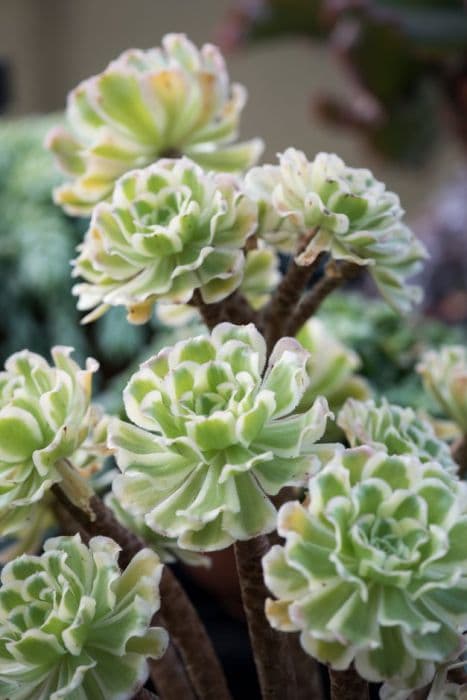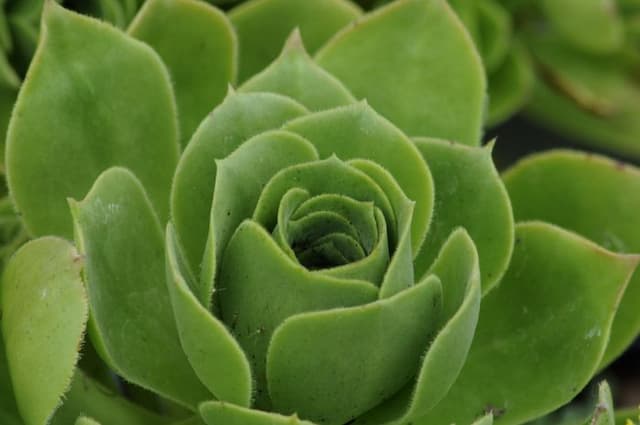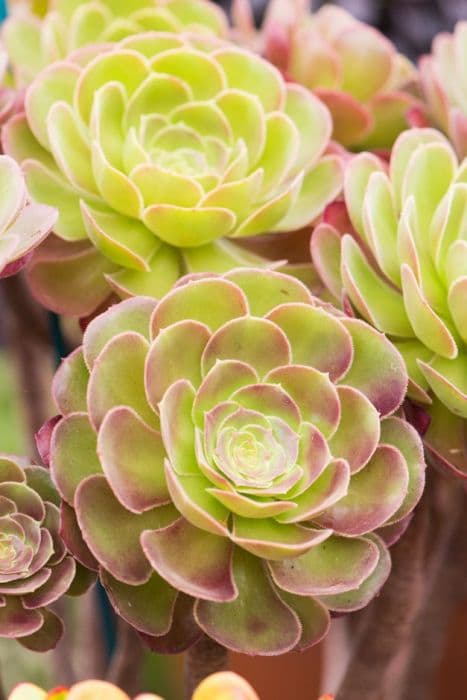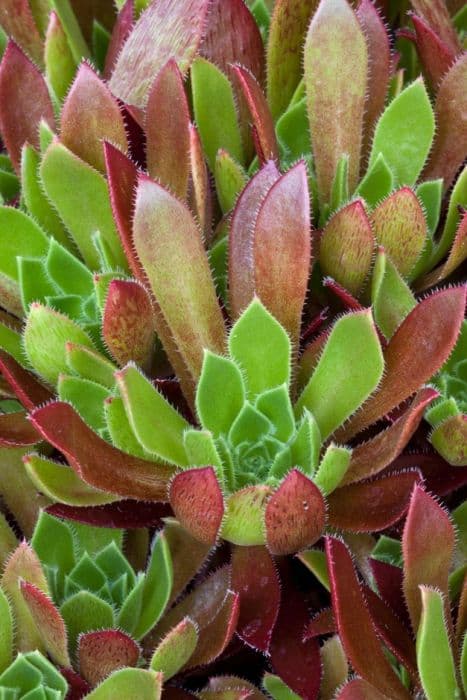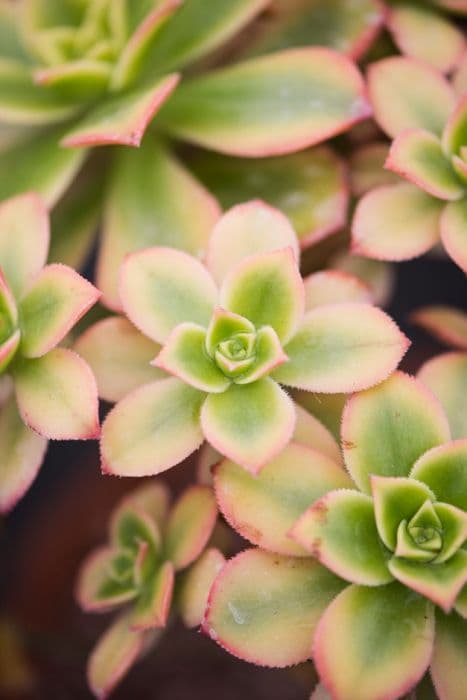Hen and Chicks Sempervivum 'Rubin'

ABOUT
Sempervivum 'Rubin', commonly known as Hen and Chicks or Houseleek, is a striking succulent plant known for its vibrant and richly colored rosettes. Its leaves are thick and fleshy, designed to retain water and thrive in dry conditions. The foliage of 'Rubin' is particularly noteworthy for its deep red or ruby coloration, which can become more intense when the plant is grown in bright sunlight or with some stress, such as cold or drought. Each rosette is made up of tightly packed leaves that radiate from the center, creating a symmetrical and visually pleasing pattern. The leaves themselves tend to be somewhat pointed at the tips, with the edges sometimes displaying a fine hint of cilia or small hair-like structures that add texture to the plant's appearance. Over time, the mother rosette, or "hen," produces small offsets that cluster around her base. These offsets, known as the "chicks," are identical in appearance to the parent plant and can eventually root and grow into new independent rosettes, forming a dense mat of succulents that can cover the ground or fill a container. This ability to propagate readily and cover ground makes Hen and Chicks a popular choice for rock gardens, green roofs, and as a low-maintenance ground cover.
About this plant
 Names
NamesFamily
Crassulaceae
Synonyms
Hen And Chicks, Houseleek
Common names
Sempervivum 'Rubin'.
 Toxicity
ToxicityTo humans
Houseleek is generally not considered toxic to humans. There are no significant toxic effects reported from ingesting this plant. However, it is not intended for consumption, and as with any non-food plants, it is possible for individuals to experience mild stomach upset or an allergic reaction if ingested or if the sap comes into contact with the skin.
To pets
Houseleek is not known to be toxic to pets. It does not typically cause any serious symptoms of poisoning in cats, dogs, or other household pets if ingested. As with humans, the plant is not intended for animal consumption, and ingestion may result in mild gastrointestinal upset due to the nature of it being a non-food plant.
 Characteristics
CharacteristicsLife cycle
Perennials
Foliage type
Evergreen
Color of leaves
Green
Flower color
Pink
Height
6 inches (15 cm)
Spread
12 inches (30 cm)
Plant type
Succulent
Hardiness zones
3
Native area
Europe
Benefits
 General Benefits
General Benefits- Easy to Grow: Sempervivum 'Rubin', commonly known as Hens and Chicks, requires minimal care and can thrive in a variety of conditions, making it ideal for novice gardeners.
- Drought Tolerant: This succulent is highly resistant to drought, conserving water in its leaves, and can survive long periods without watering.
- Cold Hardy: Hens and Chicks can endure cold temperatures, making it suitable for outdoor cultivation in many climates.
- Propagates Easily: The plant naturally produces offshoots that can be separated and used to propagate new plants, providing an ongoing supply of new growth.
- Attractive Foliage: Sempervivum 'Rubin' has striking rosettes with colorful, red-tipped leaves that add visual appeal to gardens and containers.
- Ground Cover: When planted in groups, Hens and Chicks can act as an effective ground cover, reducing soil erosion and suppressing weeds.
- Rooftop Gardening: Its shallow root system and tolerance for extreme conditions make it well-suited for green roofs and rooftop gardens.
- Versatile Design: The compact and unique appearance of Sempervivum 'Rubin' makes it excellent for rock gardens, borders, and as part of succulent arrangements.
- Pest Resistant: Hens and Chicks are generally resistant to pests, making them a low-maintenance option for gardens.
- Year-Round Interest: With evergreen foliage, Hens and Chicks provide year-round color and interest in the garden or in containers.
 Medical Properties
Medical PropertiesThis plant is not used for medical purposes.
 Air-purifying Qualities
Air-purifying QualitiesThis plant is not specifically known for air purifying qualities.
 Other Uses
Other Uses- Sempervivum 'Rubin', commonly known as Hens and Chicks, can be used as a living roof cover, providing insulation and reducing runoff as it absorbs rainwater.
- These plants are ideal as ground covers in rock gardens, where they can tolerate the harsh conditions and fill in spaces between stones attractively.
- Hens and Chicks can be utilized in living walls or vertical gardens due to their shallow root systems and low maintenance needs.
- The plant is sometimes used as an edging species along walkways or patios, serving as a living barrier that defines spaces in the landscape.
- Hens and Chicks are handy for filling in crevices in garden walls or rocks, where they grow happily with minimal soil requirements.
- They can be placed as ornamental features in fairy gardens, creating miniature landscapes with their rosette shapes resembling small trees or bushes.
- In areas with erosion issues, Hens and Chicks can help stabilize soil with their tight clusters and help prevent further degradation.
- This plant can be used in xeriscaping, which is a landscaping method that reduces or eliminates the need for supplemental water from irrigation.
- Sempervivum 'Rubin' can serve as a natural mulch, reducing weed growth and conserving soil moisture with its dense mat-forming growth habit.
- The unique color and shape of Hens and Chicks make them excellent choices for modern Artisanal plant arrangements to add visual interest and texture.
Interesting Facts
 Feng Shui
Feng ShuiThe plant Hen and Chicks is not used in Feng Shui practice.
 Zodiac Sign Compitability
Zodiac Sign CompitabilityThe plant Hen and Chicks is not used in astrology practice.
 Plant Symbolism
Plant Symbolism- Resilience: Often called "Houseleek", Sempervivum 'Rubin' symbolizes toughness and the ability to thrive in challenging conditions, as it can grow in poor soil and resists drought.
- Protection: Houseleek is traditionally thought to protect homes from lightning and fire, likely because it was commonly planted on roofs.
- Eternal Life: The botanical name Sempervivum means "always alive," symbolizing immortality and longevity, as these plants are hardy and can survive extreme conditions.
- Self-reliance: Houseleek is capable of taking care of itself without much help, representing self-sufficiency and independence.
- Family and Fertility: Its growth habit of producing offsets, or "chicks", connects Sempervivum 'Rubin' to themes of motherhood, family, and fertility.
 Water
WaterFor a Hens and Chicks plant, generally known as Sempervivum 'Rubin', water sparingly, mimicking its natural dry habitat. It is best to use the "soak and dry" method: allow the soil to dry out completely between waterings, then soak the soil thoroughly. During the growing season, in spring and summer, this may mean watering every 7-10 days, depending on climate and indoor conditions. During winter, reduce watering to once a month, as the plant goes dormant. On average, use about 8-10 ounces of water per watering for a standard 6-inch pot, less for smaller pots, more for larger ones.
 Light
LightHens and Chicks plants, including Sempervivum 'Rubin', thrive in full sun to partial shade. They do best in a location where they can receive at least 6 hours of direct sunlight per day. An east or south-facing windowsill is an ideal spot for indoor plants, whereas outdoors, a sunny rockery or slope is perfect.
 Temperature
TemperatureHens and Chicks plants, or Sempervivum 'Rubin', prefer cooler temperatures and can survive a wide range from about 20°F to 80°F. They are cold-hardy and can tolerate freezing temperatures well below 20°F, making them suitable for outdoor cultivation in many regions. The ideal temperature range for robust growth is between 65°F and 75°F.
 Pruning
PruningPruning Hens and Chicks, or Sempervivum 'Rubin', is mainly about removing dead leaves or spent rosettes. It requires minimal pruning; however, tidying up dead material can promote better air circulation and growth. Prune as needed, typically after flowering, when the mother rosette dies back. The best time for pruning is in the early spring or immediately after the flowering rosette has withered.
 Cleaning
CleaningAs needed
 Soil
SoilThe best soil mix for Hen and Chicks (Sempervivum 'Rubin') is a well-draining mixture, such as 50% potting soil and 50% perlite or coarse sand. The soil pH should ideally be slightly acidic to neutral, ranging from 6.0 to 7.5.
 Repotting
RepottingHen and Chicks (Sempervivum 'Rubin') should typically be repotted every 2-3 years to replenish soil nutrients and accommodate growth. However, as they are tolerant of tight spaces, longer intervals may be acceptable.
 Humidity & Misting
Humidity & MistingHen and Chicks (Sempervivum 'Rubin') prefer a dry climate and do well in low humidity levels, typical of arid and semi-arid environments. No specific humidity level is required.
 Suitable locations
Suitable locationsIndoor
Place Hen and Chicks in bright light indoors, allow soil to dry between waterings.
Outdoor
For Hen and Chicks, choose sunny spot, well-draining soil, water sparingly.
Hardiness zone
3-8 USDA
 Life cycle
Life cycleThe life of Sempervivum 'Rubin', commonly known as the 'Rubin' Hens and Chicks, begins with germination, which occurs when the small, black seeds make contact with moist soil and sprout. The young plant starts as a small rosette, which gradually enlarges as the plant matures. Vegetative growth continues as 'Rubin' develops offsets, or "chicks," around the mother rosette, spreading horizontally to form a dense mat. After several years, the mature rosette will produce a flower stalk, blooming with star-shaped, reddish flowers before it completes its lifecycle. Shortly after flowering, which is typically in the summer, the main rosette, or "hen," dies, leaving behind the offsets to continue the growth cycle. The chicks then grow, mature, and eventually undergo the same process, ensuring the plant's propagation and survival.
 Propogation
PropogationPropogation time
Spring-Summer
Sempervivum 'Rubin', commonly known as Hen and Chicks or Houseleek, is best propagated during the spring or early summer when the plant is actively growing. The most popular method of propagation for Sempervivum 'Rubin' is through offsets, also known as "pups". These are small rosettes that form at the base of the parent plant. To propagate, gently separate the offsets from the mother plant when they have formed their own roots, which is usually evident by a small root system beneath the offset. You can then plant these directly into a well-draining soil mix, ensuring they are not placed too deeply. Water the offsets sparingly, just enough to moisten the soil, and avoid waterlogging. New plants will establish themselves quickly, usually within a few weeks, and start forming their own offsets in time.
